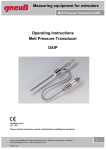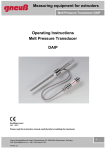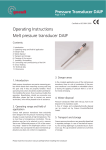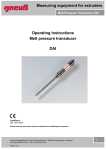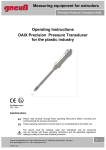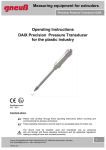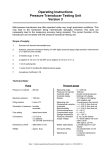Download Measuring equipment for extruders Operating Instructions
Transcript
Measuring equipment for extruders Melt Pressure Transducer DAP Operating Instructions Melt Pressure Sensor DAP Certified to ISO 9001:2008 Please read this instruction manual carefully before installing the transducer Gneuss Kunststofftechnik GmbH, Moenichhusen 42, 32549 Bad Oeynhausen, Germany, mail: [email protected], web: www.gneuss.com Version 2.0 1 Measuring equipment for extruders Melt Pressure Transducer DAP Contents: 1. Introduction 2. Operating range and field of application 3. Danger areas 4. Waste disposal 5. Transport and storage 6. Cleaning of the sensors 7 Installing / Uninstalling 8. Connecting and commissioning 9. Sensor heating 10. Technical Data 11. Dimensions Gneuss Kunststofftechnik GmbH, Moenichhusen 42, 32549 Bad Oeynhausen, Germany, mail: [email protected], web: www.gneuss.com Version 2.0 2 Measuring equipment for extruders Melt Pressure Transducer DAP 1. Introduction Melt pressure transducers are precise measuring probes which obtain their measuring accuracy and long life span only if they are properly handled. These operating instructions should be studied carefully before installing the sensor, thus ensuring a trouble-free operation. Nevertheless, should you encounter any difficulties, please feel free to contact our service technicians, who will be pleased to be of assistance. 2. Operating range and field of application: Gneuss melt pressure transducers have exclusively been designed for the pressure monitoring of liquid, doughy or pasty materials at high temperatures. These must have a homogeneous constitution. The application area has to be selected in such a manner, that a max. Differential pressure of 2% of the measuring range – based on the diaphragm surface- is not exceeded. Any use beyond the above mentioned application area does not conform to regulations 3. Danger areas: In the complete application area of the melt pressure transducer, there is a risk of combustion. If the pressure transducer is not installed or uninstalled correctly during the applying of pressure there is a risk of hot media emerging. 4. Waste disposal: Pressure transducers filled with mercury, have to be disposed of as hazardous waste. A free of charge and ecologically-friendly disposal can be carried out by Gneuss Kunststofftechnik GmbH 5. Transport and storage: Gneuss pressure transducers are generally dispatched in separate packages. In case of mechanical exposure, the sensing diaphragm is protected by an aluminium cap. This cap should be screwed on at all times of storage. Gneuss Kunststofftechnik GmbH, Moenichhusen 42, 32549 Bad Oeynhausen, Germany, mail: [email protected], web: www.gneuss.com Version 2.0 3 Measuring equipment for extruders Melt Pressure Transducer DAP 6. Cleaning of the sensors In order to clean the diaphragm, the sealing surface and the process thread the sensor must have the same temperature as the plastic melting point. The diaphragm and the sealing surface can be wiped down with a soft cloth, the thread can be cleaned with a steel brush. (Do not come into contact with the diaphragm surface) 7. Installing / Uninstalling Installing On installation of the pressure transducer it is imperative to note, that the sensor bore corresponds to the dimensions mentioned below. The fitting accuracy can be checked by means of a test bolt Prior to mounting the sensor, the thread should be covered with a heat resistant paste. Should the machinery with the sensor drilling still be at production temperature, a certain preheating period for the sensor should be taken into consideration, in order to avoid a seizing of the sensor due to thermal expansion. On mounting the transducer, it is important to note that the sensor is not screwed in at an angle and that the sensor does not fall into the bore. It is of vital importance that the force for installing the sensor must only be applied at the shaft (hexagon). Do not apply any force to the sensor head! Starting torque for 1/2-20 UNF = max. 30 Nm Starting torque for M 18 x 1,5 = max. 50 Nm Uninstalling The uninstalling of the pressure transducer has to be done in a heated up condition (plastic melting point) On removal of the sensor, please take note that the diaphragm is not brought into contact. It is of vital importance that the force for installing the sensor must only be applied at the shaft (hexagon). Do not apply any force to the sensor head! 45°±1° ( d2 ) ( d4 ) ( d3 ) ( d1 ) 0,05 A A (c) (b) (a) d1 d2 d3 d4 a b c M18x1,5 ½“20UNF 2A +0,05 Ø 10,1 Ø 7,9 +0,05 Ø 16,1 +0,1 Ø 10,7 +0,1 Ø 20 +0,2 Ø 13 +0,2 6,1 –0,1 5,7 –0,1 4 –0,2 3,2 –0,2 25 19 Gneuss Kunststofftechnik GmbH, Moenichhusen 42, 32549 Bad Oeynhausen, Germany, mail: [email protected], web: www.gneuss.com Version 2.0 4 Measuring equipment for extruders Melt Pressure Transducer DAP 8. Connections and commissioning After the pressure transducer has been mounted into the line as is described in section 7, the electrical connection then has to be carried out according to the connections indicated on next page. Gneuss pressure transducers are equipped with high-quality and robust plug connections. The connecting wire should be soldered with great care since otherwise, transmission errors of signals can be caused. We recommend you to use Gneuss prefabricated connecting wires which are available from stock. For the commissioning, the sensor and the corresponding evaluation unit (e.g. Gneuss pressure measurement amplifier) have to be calibrated accordingly. The calibrating process has to be carried out when the line is heated up and at zero pressure. Please take the details concerning the way how to proceed from the respective operating instructions for the evaluation unit. Electrical wiring Plug type in sensor PT 02A-10-6P Plug type socked PT 06W-10-6S Gneuss order number: E0000_0043 Calibration 80 % Signal + Pin FA B E C D Function Signal - (Gneuss – cables) Supply + Supply No function A Signal + Yellow B Signal - White C Supply + Brown D Supply - Green E No function Pink F Calibration 80% Grey Gneuss Kunststofftechnik GmbH, Moenichhusen 42, 32549 Bad Oeynhausen, Germany, mail: [email protected], web: www.gneuss.com Version 2.0 Colour scheme 5 Measuring equipment for extruders Melt Pressure Transducer DAP Thermo couple connection: PCA.0S.302.CLL 1 + 2 - Thermocouple Heater connection: PCA.3S.302.CLL 24 VAC / 150 W Sensor heating Gneuss Kunststofftechnik GmbH, Moenichhusen 42, 32549 Bad Oeynhausen, Germany, mail: [email protected], web: www.gneuss.com Version 2.0 6 Measuring equipment for extruders Melt Pressure Transducer DAP 9. Sensor Heating The pressure transducer DAIpremium is a high-efficient sensor with integrated thermocouple and integrated heating element. During the production process, the thermocouple can be used as control measurement at any time. The integrated heating serves to protect the sensor from damage to the membrane when processing problematic plastic melts, e.g. polycarbonate, since these contract very much when cooling down. In the production process, it is sufficient to set the nominal value of the temperature control approx. 30-50°C below the melt temperature. By switching on the heating, the front part of the sensor incl. membrane can be adjusted to such a temperature that the melt in the membrane area remains viscous. Further, the heating can be used to help to remove the sensor out of a “cold” machine. For this, it is normally sufficient to heat up the sensor for approx. 15 to 30 minutes (depending on the temperature). Attention: The sensor heating must always be controlled by the integrated thermocouple. The sensor should only be heated up when being installed, otherwise the heating element might be damaged. During the heating process, the temperature level in the whole sensor and drilling area can be very high. After having installed the pressure transducer in the line as described under point 7, the electrical connection has to be carried out according to the connections indicated section 8. Gneuss Kunststofftechnik GmbH, Moenichhusen 42, 32549 Bad Oeynhausen, Germany, mail: [email protected], web: www.gneuss.com Version 2.0 7 Measuring equipment for extruders Melt Pressure Transducer DAP 10.Technical Data: Pressure range: See order specification Supply : 6…10V maximum current consumption 28,6 mA @ 10V Outputsignal: 2mV/V bzw. 3,3 mV/V (see order specification) Bridge resistance: 350 Temperature element: Type J; K; L, PT 100 (see order specification) Heater : 24V 150W Calibration point: 80 % of measuring range Accuracy: 0,50 % FSO respectively specification) Maximum over load: 150% of measuring range Zero deviation with Temperature Variations at the membrane:: 0,3 bar / 10K Zero deviation with Temperature Variations at the measuring head: 0,2 % FSO / 10K Maximum temperature at the membrane: 0,25 % FSO (see order 300°C with NTX-filling (W) 400°C with Hg-filling (M) 500°C with NaK-filling (N) Maximum. Temperature at the measuring head: 125 °C EMC: according to Electromagnetic disturbances and electromagnetic susceptibility EN 61326 Degree of protection: IP 55 Gneuss Kunststofftechnik GmbH, Moenichhusen 42, 32549 Bad Oeynhausen, Germany, mail: [email protected], web: www.gneuss.com Version 2.0 8 Measuring equipment for extruders Melt Pressure Transducer DAP 11. Dimensions For available variations see order specification Gneuss Kunststofftechnik GmbH, Moenichhusen 42, 32549 Bad Oeynhausen, Germany, mail: [email protected], web: www.gneuss.com Version 2.0 9 Measuring equipment for extruders Melt Pressure Transducer DAP Gneuss Kunststofftechnik GmbH, Moenichhusen 42, 32549 Bad Oeynhausen, Germany, mail: [email protected], web: www.gneuss.com Version 2.0 10 Measuring equipment for extruders Melt Pressure Transducer DAP Gneuss Kunststofftechnik GmbH, Moenichhusen 42, 32549 Bad Oeynhausen, Germany, mail: [email protected], web: www.gneuss.com Version 2.0 11 Measuring equipment for extruders Melt Pressure Transducer DAP Gneuss Kunststofftechnik GmbH Moenichhusen 42 32549 Bad Oeynhausen, Germany Phone: +49 (0) 5731 5307-0 Fax: +49 (0) 5731 5307-77 Mail: [email protected] www.gneuss.de Gneuss Kunststofftechnik GmbH, Moenichhusen 42, 32549 Bad Oeynhausen, Germany, mail: [email protected], web: www.gneuss.com Version 2.0 12












